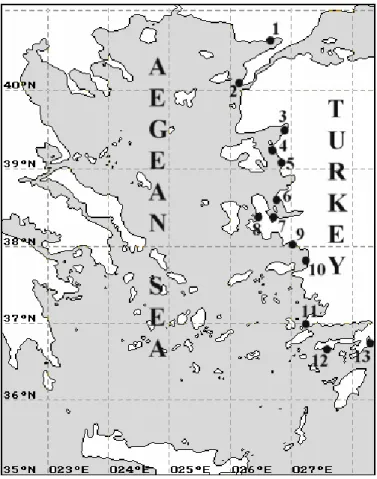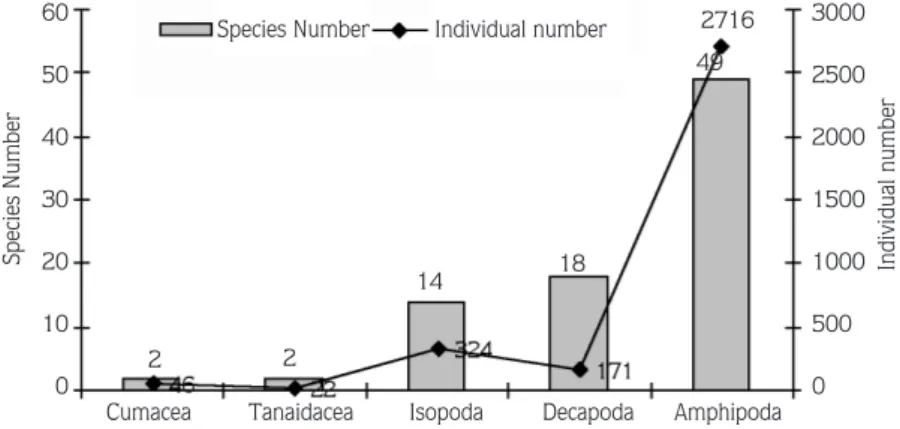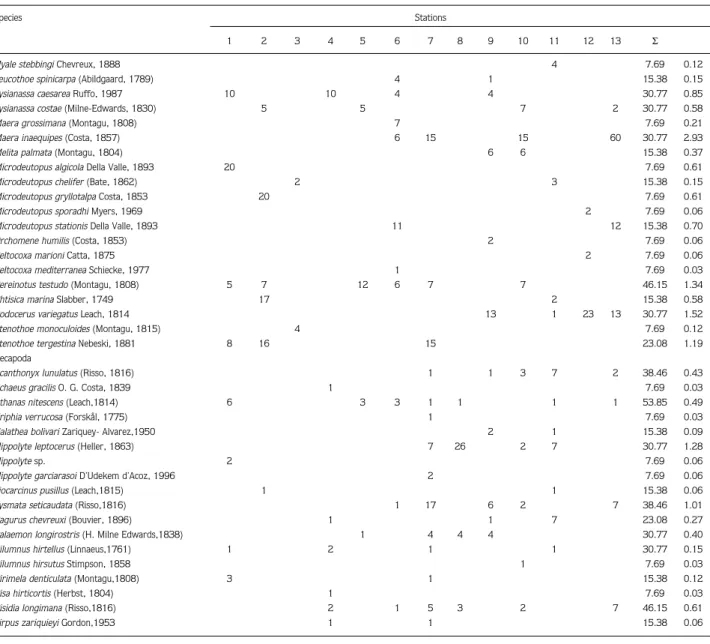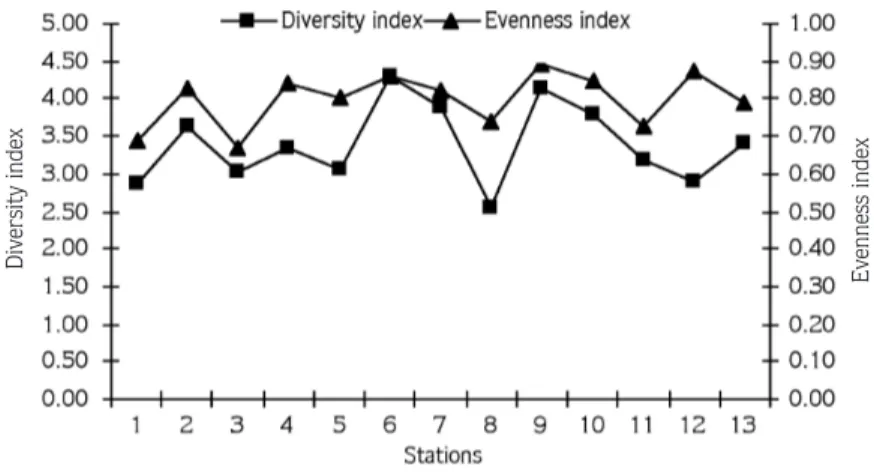Introduction
Photophilic algae represent a substrate with a particular structure populated by a great number of animals. The mass of these photophil organisms makes a marked contribution to raising the productivity of the marine coast (Tiganus, 1972).
Padina pavonia is a representative of brown algae (Phaeophyceae), usually located on rocky substrates, various shell bottoms and coral fragments in shallow waters, and show a wider distribution in unpolluted enviroments. Peres and Picard (1964) indicated that P. pavonia facies usually occur in shallow waters due to its tolerance to variations in edaphic factors. In the Aegean Sea P. pavonia is a member of the genus Padina, which is
represented by 4 species (P. boergesenii, P. pavonia, P. tenuis and P. gymnospora) in the Mediterranean Sea (European Register of Marine Species, 2003).
Bellan-Santini (1969) investigated the P. pavonia facies in unpolluted and calm waters of Marseilles Bay in the Mediterranean using qualitative and quantitative methods. Russo (1997) studied the epifauna associated with some algae species and P. pavonia on the coasts of Cyprus. Studies on the macrobenthic fauna inhabiting algae facies of the coastal hard substratum, especially P. pavonia, in the Turkish Aegean Sea are scarce. Studies were conducted by Kocatafl (1978), Ergen (1980), Ergen et al. (1985), Ergen et al. (1994), and Öztürk and Ergen (2000), the majority of which concentrated on Mollusca and Polychaeta groups in the vicinity of ‹zmir Bay. The
Crustacean Biodiversity of Padina pavonia (L.) Facies Along the
Aegean Coasts of Turkey
Fevzi KIRKIM, Ahmet KOCATAfi, Tuncer KATA⁄AN
Ege University, Fisheries Faculty, Hydrobiology Section, 35100, Bornova, ‹zmir - TURKEY
Murat SEZG‹N
Ondokuz May›s University, Fisheries Faculty, Hydrobiology Section, 57000, Sinop - TURKEY e-mail: msezgin@omu.edu.tr
A. Suat ATEfi
Onsekiz Mart University, Fisheries Faculty, Hydrobiology Section, 18000, Çanakkale - TURKEY
Received: 24.03.2004
Abstract: This research was carried out to determine the crustacean species associated with Padina pavonia facies distributed in the upper-infralittoral zone of the Aegean Sea coasts of Turkey and their bioecological features. The investigations were performed at depths of 2-5 m in 13 different stations chosen in the Aegean Sea in June and July, 1995. As a result of the study, a total of 3279 specimens belonging to 85 species were identified. Of these, Ampithoe ramondi was commonest with a dominance value of 21.47%, followed by Elasmopus pocillimanus with 13.94% and Ericthonius brasiliensis with 4.61%.
Key Words: Diversity, Padina pavonia, Crustacea, Aegean Sea, Turkey
Türkiye’nin Ege Denizi K›y›lar› Padina pavonia (L.) Fasiesinin Crustacea Çeflitlili¤i
Özet: Bu araflt›rma Türkiye’nin Ege Denizi k›y›lar›n›n üst infralittoral zonunda da¤›l›m gösteren Padina pavonia fasiesinin Crustacea türlerini tespit etmek amac›yla yürütülmüfltür. Araflt›rmalar 1995 y›l›n›n haziran ve temmuz aylar›nda Ege Denizi’nde seçilen 13 farkl› istasyonda 2-5 m derinliklerde gerçeklefltirilmifltir. Sonuç olarak 85 türe ait toplam 3279 birey tan›mlanm›flt›r. Bunlardan Ampithoe ramondi % 21,47’ lik dominansi de¤eri ile en yayg›n tür olurken, bunu % 13,94 ile Elasmopus pocillimanus ve % 4,61 ile Ericthonius brasiliensis izlemektedir.
most specific study on crustacean fauna within P. pavonia facies was carried out by Kocatafl (1976).
Therefore, samplings in this study were made over a wider geographical range capable of representing the Turkish Aegean Sea coasts, and we aimed to examine the crustacean fauna associated with P. pavonia facies based on qualitative and quantitative data.
Materials and Methods
In order to determine crustacean assemblages within P. pavonia facies, samplings were performed at 13 different localities (1. Saros Bay-Güneyli, 2. Çanakkale-Monument, 3. Alt›noluk, 4. Ayval›k, 5. Dikili, 6. Foça, 7. Urla, 8. Çeflme, 9. S›¤ac›k-Seferihisar, 10. Kufladas›, 11. Bodrum, 12. Datça, and 13. Marmaris, from North to South) in the upper-infralittoral zone of the Aegean Sea. Samples were collected according to the methodology proposed by Bellan-Santini (1969), and a 400 cm2 unit
area was sampled for P. pavonia facies. For this purpose, a metal frame (20 x 20 cm) covared with a bag made up of a plankton net was used.
The P. pavonia roots and leaves within the metal frame were excavated using a spatula, and the material collected was preserved in 4% formalin for further analysis back in the laboratory. The samples were washed through a 1 mm sieve and the crustacean specimens were sorted. The extracted fauna was separated into taxonomic groups, identified and counted under a stereomicroscope. Groups were identified and listed according to the revisions given by Bacescu (1951) (Cumacea), Riggio (1973) (Tanaidacea), Giordoni-Soika (1950), Holdich (1968; 1970) (Isopoda), Ruffo (1982, 1989, 1993, 1998) (Amphipoda) and Zariquiey Alvarez (1968), D’Udekem D’Acoz (1996) and Falciai and Minervini (1996) (Decapoda).
To eludicate the community structure, Soyer’s (1970) frequency index (ƒ %), Bellan-Santini’s (1969)
quantitative dominance index (DI %), Shannon-Weaver’s (1949) diversity index (H1), Pielou’s (1975) evenness index and Bray-Curtis’s (1957) similarity index were calculated.
The frequency index of a particular species was estimated by
ƒ = m / M x 100, where m = number of stations where the species was found and M = number of all stations.
The dominance index of a certain species was estimated by
DI = m / M x 100, where m = individual number of a species in the stations and M = total individual numbers of all species.
The Shannon-Weaver diversity index was estimated by
where S = total individual number of a species and N = total individual numbers of all species.
The Pielou evenness index was estimated by
where H1
= Shannon index value; S = species number The Bray-Curtis similarity index was estimated by Sjk = 100 {1- Σyij- yik/Σyij+ yik}
Results
As a result of the study, carried out at 13 different stations along the Turkish Aegean Sea coast, a total of 3279 individuals belonging to 85 species (2 Cumacea, 2 Tanaidacea, 14 Isopoda, 18 Decapoda and 49 Amphipoda) were recorded (Figure 2, Table 1).
The highest number of species was observed at station 6 (Foça) with 32 species, was followed by station 7 (Urla-Karantina Island) with 27 species and station 9 (S›¤ac›k) with 25 species, and the lowest number was at station12 (Datça) with 10 species. The highest number of specimens was at station 3 with 430 specimens, whereas the lowest value was recorded at station 4 (Ayval›k) (Figure 3).
The differences among the stations are in accordance with their substrate heterogeneity. At some stations P. pavonia constitutes a poor facies and its vicinity is surrounded with naked stones. However, at stations with both species and specimen richness at high values P. pavonia comprises dense facies and is covered with dense algae facies such as Cystoseira spp. and Halopteris spp. Crustacean species occur in dense populations in such biotopes.
Shannon-Weaver diversity index values (H1
) among the sampling stations did not show significant difference, and these values ranged between 4.32 and 2.56. The highest DI value was at station 6 (Foça) and the lowest DI value at station 8 (Çeflme) (Figure 3). The evenness index (J1) values mainly ranged between 0.69 and 0.89, revealing that the distribution of species at the stations is regular. However, at station 8 (Çeflme), Ampithoe J1 = H1 log2 S , pi = S N , H1 = -
∑
logpi • log2 pi 1-0 nSpecies Number Individual number 60 50 40 30 20 10 0 3000 2500 2000 1500 1000 500 0
Species Number Individual number
Cumacea Tanaidacea Isopoda Decapoda Amphipoda
49 2716 18 14 2 2
Table. List of species, numbers of individuals at stations, values of dominance and abundance. Species Stations 1 2 3 4 5 6 7 8 9 10 11 12 13 Σ Total individual 216 278 117 430 214 258 404 262 154 374 202 133 237 3279 Total species 18 21 16 23 14 32 27 11 22 25 21 10 20 85 Cumacea ƒ% DI% Bodotria scorpioides (Montagu, 1804) 2 1 2 23.08 0.15
Cumella limicola Sars, 1879 3 2 1 29 1 3 1 1 61.54 1.25
Tanaidacea
Apseudes robusrus G.O. Sars, 1882 1 7.69 0.03
Leptochelia savignyi (Kroyer, 1842) 1 1 3 1 4 1 9 1 61.54 0.64
Isopoda
Carpias stebbingi (Monod, 1939) 2 3 5 36 12 17 13 5 18 10 76.92 3.69
Bopyrus squillarum Latreille, 1802 1 2 15.38 0.09
Cymodoce emarginata Leach, 1818 6 3 2 3 4 3 21 53.85 1.28
Cymodoce spinosa (Risso, 1816) 4 5 15.38 0.27
Cymodoce truncata Leach, 1814 4 3 2 3 30.77 0.37
Cymodoce tuberculata Costa in Hope, 1851 3 3 15.38 0.18
Dynamene edwardsi (Lucas, 1849) 5 4 6 23.08 0.46
Dynamene magnitorata Holdich, 1968 3 2 15.38 0.15
Dynamene torelliae Holdich, 1968 22 31 6 7 30.77 2.01
Joeropsis brevicornis subsp. littoralis Amar, 1949 7 12 7 23.08 0.79
Uromunna petiti (Amar, 1948) 2 7.69 0.06
Paranthura costana Bate & Westwood, 1868 3 1 15.38 0.12
Synisoma capito (Rathke, 1837) 4 2 1 23.08 0.21
Synisoma appendiculata (Risso, 1816) 3 3 15.38 0.18
Amphipoda
Ampelisca pseudospinimana Bellan-Santini &
Kaim-Malka, 1977 2 7.69 0.06
Amphilochus neapolitanus Della Valle, 1893 11 1 17 12 30.77 1.25
Ampithoe ferox (Chevreux, 1902) 13 7.69 0.40
Ampithoe helleri Karaman, 1975 2 7.69 0.06
Ampithoe ramondi Audouin, 1826 55 55 22 130 50 50 101 90 27 47 27 25 25 100.00 21.47
Aora spinicornis Afonso, 1976 3 7 15.38 0.30
Apherusa bispinosa (Bate, 1857) 1 11 15.38 0.37
Apherusa chiereghinii Giordani- Soika, 1950 17 7 15.38 0.73
Apherusa vexatrix Krapp-Schickel, 1979 10 17 45 23.08 2.20
Atylus guttatus (Costa, 1851) 8 7 30 23.08 1.37
Atylus massiliensis Bellan-Santini, 1975 22 7.69 0.67
Caprella acanthifera Leach, 1814 3 25 15.38 0.85
Caprella grandimana Mayer, 1882 7 22 15.38 0.88
Caprella rapax Mayer, 1890 9 27 22 17 17 12 14 53.85 3.60
Colomastix pusilla Grube, 1861 3 7.69 0.09
Corophium acherusicum Costa, 1851 7 7.69 0.21
Corophium sp. 2 7.69 0.06
Cymadusa crassicornis (Costa, 1857 47 13 30 23.08 2.74
Dexamine spiniventris (Costa, 1853) 1 32 25 32 26 9 17 27 15 12 5 31 92.31 7.08
Dexamine spinosa (Montagu, 1813) 17 15 22 11 30.77 1.98
Elasmopus affinis Della Valle, 1893 67 7.69 2.04
Elasmopus brasiliensis (Dana, 1855) 6 7.69 0.18
Elasmopus pocillimanus (Bate, 1862) 80 15 120 50 20 40 12 30 40 50 76.92 13.94
Ericthonius brasiliensis (Dana, 1855) 22 12 22 75 12 8 46.15 4.61
Ericthonius punctatus (Bate, 1857) 12 12 15.38 0.73
Eusiroides dellavallei Chevreux, 1899 3 7.69 0.09
Gammarella fucicola (Leach, 1814) 1 12 15.38 0.40
Guernea coalita (Norman, 1868) 12 3 11 9 30.77 1.07
Hyale stebbingi Chevreux, 1888 4 7.69 0.12
Leucothoe spinicarpa (Abildgaard, 1789) 4 1 15.38 0.15
Lysianassa caesarea Ruffo, 1987 10 10 4 4 30.77 0.85
Lysianassa costae (Milne-Edwards, 1830) 5 5 7 2 30.77 0.58
Maera grossimana (Montagu, 1808) 7 7.69 0.21
Maera inaequipes (Costa, 1857) 6 15 15 60 30.77 2.93
Melita palmata (Montagu, 1804) 6 6 15.38 0.37
Microdeutopus algicola Della Valle, 1893 20 7.69 0.61
Microdeutopus chelifer (Bate, 1862) 2 3 15.38 0.15
Microdeutopus gryllotalpa Costa, 1853 20 7.69 0.61
Microdeutopus sporadhi Myers, 1969 2 7.69 0.06
Microdeutopus stationis Della Valle, 1893 11 12 15.38 0.70
Orchomene humilis (Costa, 1853) 2 7.69 0.06
Peltocoxa marioni Catta, 1875 2 7.69 0.06
Peltocoxa mediterranea Schiecke, 1977 1 7.69 0.03
Pereinotus testudo (Montagu, 1808) 5 7 12 6 7 7 46.15 1.34
Phtisica marina Slabber, 1749 17 2 15.38 0.58
Podocerus variegatus Leach, 1814 13 1 23 13 30.77 1.52
Stenothoe monoculoides (Montagu, 1815) 4 7.69 0.12
Stenothoe tergestina Nebeski, 1881 8 16 15 23.08 1.19
Decapoda
Acanthonyx lunulatus (Risso, 1816) 1 1 3 7 2 38.46 0.43
Achaeus gracilis O. G. Costa, 1839 1 7.69 0.03
Athanas nitescens (Leach,1814) 6 3 3 1 1 1 1 53.85 0.49
Eriphia verrucosa (Forskål, 1775) 1 7.69 0.03
Galathea bolivari Zariquey- Alvarez,1950 2 1 15.38 0.09
Hippolyte leptocerus (Heller, 1863) 7 26 2 7 30.77 1.28
Hippolyte sp. 2 7.69 0.06
Hippolyte garciarasoi D'Udekem d'Acoz, 1996 2 7.69 0.06
Liocarcinus pusillus (Leach,1815) 1 1 15.38 0.06
Lysmata seticaudata (Risso,1816) 1 17 6 2 7 38.46 1.01
Pagurus chevreuxi (Bouvier, 1896) 1 1 7 23.08 0.27
Palaemon longirostris (H. Milne Edwards,1838) 1 4 4 4 30.77 0.40
Pilumnus hirtellus (Linnaeus,1761) 1 2 1 1 30.77 0.15
Pilumnus hirsutus Stimpson, 1858 1 7.69 0.03
Pirimela denticulata (Montagu,1808) 3 1 15.38 0.12
Pisa hirticortis (Herbst, 1804) 1 7.69 0.03
Pisidia longimana (Risso,1816) 2 1 5 3 2 7 46.15 0.61
Sirpus zariquieyi Gordon,1953 1 1 15.38 0.06
Table (contuened)
Species Stations
1 2 3 4 5 6 7 8 9 10 11 12 13 Σ
Species and individual numbers
ramondi and Ericthonius brasiliensis (Amphipoda), which are represented by 90 and 75 specimens respectively, lowered the evenness index value (Figure 4).
For the relative importance of crustacean species sampled from the 13 stations, the Soyer frequency index was computed and 9 species were designated as very common, 19 species as common and 57 species as rare. Four species, which had the highest values and are very common in P. pavonia facies, are Ampithoe ramondi (100%), Dexamine spiniventris (92.3%), Elasmopus pocillimanus and Carpias stebbingi (76.9%).
Apseudes robustus, Uromunna petiti, Ampelisca pseudospinimana, Ampithoe helleri, Atylus massilensis, Colomastix pusilla, Corophium acherisicum, Corophium sp., Elasmopus affinis, E. brasiliensis, Eusiroides dellavallei, Hyale stebbingi, Maera grossimana, Microdeutopus algicola, M. gryllotalpa, M. sporadhi, Orchomene humilis, Peltocoxa marioni, P. mediterranea,
Stenothoe monoculoides, Acheus gracilis, Eriphia verrucosa, Hippolyte sp., Hippolyte garciarasoi, Pilumnus hirsutus and Pisa hirticortis were recorded from only 1 of the 13 stations and are rare species of this community. A. ramondi was the most dominant crustacean species with 771 specimens (21.48%) followed by E. pocillimanus with 513 specimens (13.9%) and E. brasiliensis 163 (4.6%) at P. pavonia facies (Figure 6).
According to results of the Bray-Curtis similarity index, 2 stations (station 1 and 5) with a value of 58%, and stations 7 and 8, and 10 and 12 with a value of 50% shared the same groups (Figure 7).
Discussion
A total of 3279 individuals belonging to 85 crustacean species were recorded from 13 different P. pavonia facies along the Aegean Sea coast of Turkey.
Diversity index
Evenness index
Figure 5. Dispersion of species as a result of 3 frequency index group
values. Figure 6. Dominance values of species.
In studies previously carried out on P. pavonia facies Bellan-Santini (1969) reported 115 species (25 algae and 90 animal species) from Marseilles Bay in the Mediterranean Sea. Ergen et al. (1985) recorded 91 species and 1156 individuals belonging to different benthic macrofauna groups at Urla (station 7 in this study) and recorded the rate of crustacean species as 31.9%. Kocatafl (1978) indicated that 28 out of 48 amphipod species were recorded in P. pavonia communities from the rocky substrates in the upper-infralittoral zone of ‹zmir Bay. Kocatafl (1978) reported that 65 crustacean species, from a total of 231 species, were recorded in P. pavonia facies during his investigations into benthic forms of rocky shores in ‹zmir Bay. Ergen (1980) recorded 48 Polychaeta species in P. pavonia facies during his study to 5 facies in ‹zmir Bay. Ergen et al. (1994) reported 57 crustacean species on soft and hard bottoms including P. pavonia facies at
Gencelli Harbour (Alia¤a-‹zmir) Öztürk and Ergen (2000) reported 19 gastropod species in P. pavonia facies of 24 stations located on the Turkish coast of the Aegean Sea. When all the previous studies mentioned above are considered, our study includes the richest number of crustacea species.
A comparison of the sampling stations, in terms of the northern Aegean (1-8) and southern Aegean (8-13) revealed that the crustacean species diversity is somewhat higher in the southern Aegean Sea. This can be explained by the wider range of sampling stations that represent various habitats, and consequently by P. pavonia facies being exposed to different hydrographical conditions. In addition, the Aegean Sea, serving as a transition zone between the Mediterranean and Black Sea, also impacts on the wide distribution of marine organisms (Kocatafl and Bilecik, 1992).
0
50
100
Bray-Curits similarity index (100%)
St. 1 St. 5 St. 6 St. 7 St. 8 St. 9 St. 1 St. 10 St. 11 St. 12 St. 13 St. 3 St. 11 Figure 7. Similarity among the stations (Bray-Curtis).
References
Bacescu, M. 1951. Cumacea Fauna R.P.R. IV, Bucureflti, 94 p. Bellan-Santini, D., Karamani G., Krapp-Schickel, G., Ledoyer, M., Myers,
A.A., Ruffo, S. and Schiecke, U. 1982. Gammaridea (Acanthonozomatidae to Gammaridae). In: Sandro Ruffo (ed.), The Amphipoda of the Mediterranean, Part I, Mémoires de l’Institut Océanographique, Monaco, 13: 364 p.
Bellan-Santini, D. 1969. Contribution à l’étude des peuplement infralittoraux sur substrat rocheux (Etude qualitative et quantitative de la franch Superiere), Recherche Travaux Station Marine Endoume, France, 63 (47): 9-294.
Bellan-Santini, D., Diviacco, G., Krapp-Schickel, G., Myers, A.A. and Ruffo, S. 1989. Gammaridea (Haustoriidae to Lysianassidae). In: Sandro Ruffo (ed.), The Amphipoda of the Mediterranean, Part II, Mémoires de l’Institut Océanographique, Monaco, 13: 365-576. Bellan-Santini, D., Karaman, G.S., Krapp-Schickel, G., Ledoyer, M. and
Ruffo, S. 1993. Gammaridea (Melphidippidae to Talitridae) Ingolfiellidea, Caprellidae, In: Sandro Ruffo (ed.), The Amphipoda of the Mediterranean, Part III, Mémoires de l’Institut Océanographique, Monaco, 13: 577-813.
Bellan-Santini, D., Karaman, G.S., Ledoyer, M., Myers, A.A., Ruffo, S. and Vader, W. 1998. Localities and Map, Addenda to Parts 1-3, Key to Families, Ecology, Faunistics and Zoogeography, Bibliography, Index. In: The Amphipoda of the Mediterranean, Sandro Ruffo (ed.). Part 4, Mémoires de l’Institut Océanographique, Monaco, 13: 815-959.
Bray, J.R. and Curtis, J.T. 1957. An ordination of the upland forest communities of South Wisconsin. Ecological Monographs, 27: 325-347.
D’Udekem D’Acoz, C. 1996. The Genus Hippolyte Leach, 1814 (Crustacea: Decapoda: Caridea: Hippolytidae) in the East Atlantic Ocean and the Mediterranean Sea, with a checklist of all species in the genus, Zool. Verh., 30 ix. : 1-133.
European Register of Marine Species. 2003 Algae: brief check list, accessible via E.R.M.S Home Page on WWW.).
Ergen, Z. 1980. ‹zmir Körfezi’nde üst infralittoral zonun baz› fasieslerinde Polychaeta’n›n karfl›laflt›rmal› olarak incelenmesi, TÜB‹TAK VII. Bilim Kongresi, Kufladas›, Ayd›n, 275-284. Ergen, Z., Kocatafl, A. and Kata¤an, T. 1985. Evolution Des
Peuplements a Padina pavonia dans le Golfe d’Izmir (Turquie). Rapp. Comm. Int. Mer Médit., 29(5): 317-319.
Ergen, Z., Kocatafl, A., Kata¤an, T. and Ç›nar, M.E. 1994. Gencelli Liman› (Alia¤a-‹zmir) Bentik Faunas›, E.Ü. Fen Fakültesi Dergisi Seri B, 16(2): 1047-1059.
Falciai, L. and Minervini, R. 1996. Guide des Homards, Crabes, Longoustes, Crevettes et Autres Crustacés Décapodes d’ Europe, Delachaux et Niestle SA, Lausanne-Paris, 287 p.
Giordani-Soika, A. 1950. Tanaidacei degli Isopodi marini della laguna di Venezia, Archiv. Oceanogr. Limnologia, 7(2-3): 213-238. Holdich, D.M. 1968. Reproduction, growth and bionimics of Dynamene
bidentata (Crustacea: Isopoda), J. Zool., London, 156: 137-153. Holdich, D.M. 1970. The distribution and habitat preferences of the Afro-European species of Dynamene (Crustacea: Isopoda), I. Nat. Hist., 4: 419-438.
Kocatafl, A and Bilecik, N. 1992. Ege Denizi ve Canl› Kaynaklar›, T.C. Tar›m ve Köyiflleri Bakanl›¤›, Su Ürünleri Araflt›rma Enstitüsü Müdürlü¤ü, Bodrum, Seri A, 7: 1-88.
Kocatafl, A. 1976. Note préliminare sur les Amphipodes recueillis dans les horizons supérieurs de l’étage infralittoral rocheux du golfe d’Izmir (Turquie). Téthys 7(2-3): 235-239.
Kocatafl, A. 1978. ‹zmir Körfezi kayal›k sahillerinin bentik formlar› üzerinde kalitatif ve kantitatif araflt›rmalar, Ege Üniversitesi Fen Fakültesi Monografiler Serisi, ‹zmir, 12: 1-93.
Öztürk, B. and Ergen, Z. 2000. Les Archéogastéropodes (Mollusca-Gastropoda) du littoral Turc de la Mer Egée. Acta Adriat., 41(2): 59-70.
Peres, J.M. and Picard, J. 1964. Nouveau manuel de bionomie benthique de la Mer Mediterranée. Rec. Trav. Sta. Mar. Endoume 31(47): 5-137.
Pielou, E.C. 1975. Ecological Diversity. Wiley-Inter Science Publ., London.
Riggio, S. 1993. I Tanaidacei dei Mari Italiani: Quadro Delle Conoscenze. Bull. Mus. Civ. St. Nat. Verona, 20(2): 583-698.
Russo, R.A. 1997. Epifauna living on sublittoral seaweeds around Cyprus, Hydrobiologia 344: 169-179.
Shannon, C.E. and Weaver, V. 1949. A mathematical theory of communication, Univ. Pres, Illinois, Urbana: 101-117.
Soyer, J. 1970. Bionomie benthique du plateau continental de la côte catalane française. III. Les peuplements de Copepodes harpacticoides (Crustacea), Vie et Milieu, 21: 337-511. Tiganufl, V. 1972. Ecologic observations on the Fauna Associated to the
Cystoseira Belt along the Romanian Black Sea Coast. Cercetãri Marine, I.R.C.M., 4: 153-167.
Zariquiey Alvarez, R. 1968. Crustáceos Decápodos Ibéricos, investigacion pesquera, 32, 510 p.



